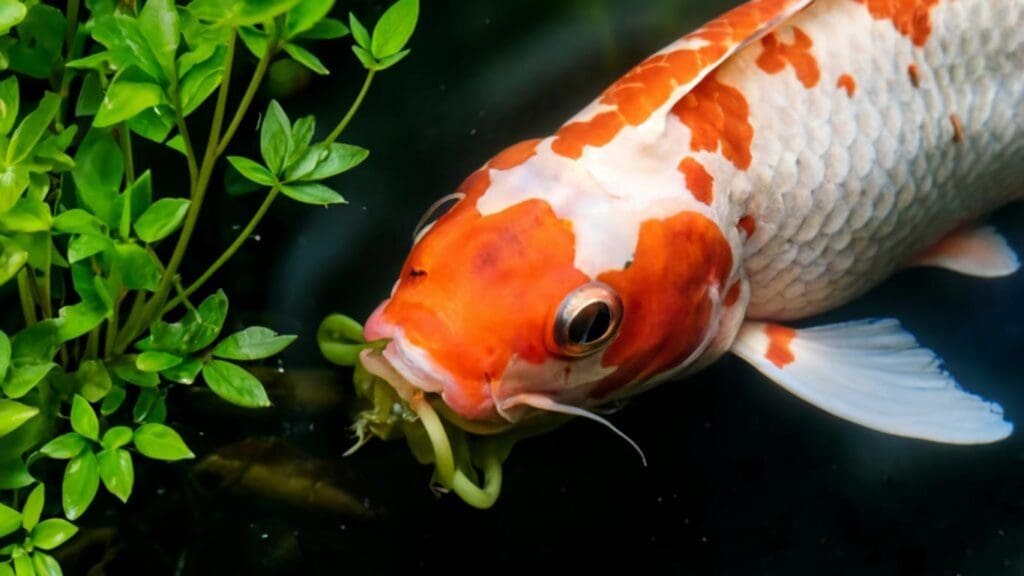Do you have a koi pond and are wondering whether your koi fish will eat your pond plants? The answer is yes, koi do eat pond plants, but not all plants are on their menu. In this article, we will discuss what plants koi fish eat, how it impacts your pond, and how to manage ‘Do Koi Eat Pond Plants’.
Understanding the koi diet is essential to knowing what plants they will eat. Koi are omnivores, which means they eat both plants and animals. Their natural diet consists of insects, crustaceans, and plants. When it comes to pond plants, koi will eat both floating and submerged plants. However, not all plants are equally appetizing to them. This makes the question ‘Do Koi Eat Pond Plants’ particularly relevant for koi pond owners.
Now that you know koi do eat pond plants, it’s important to understand the impact it can have on your pond. Eating too many plants can cause digestive problems for your koi and affect the pond’s ecosystem. It can also lead to excessive algae growth, which can harm your fish. Fortunately, there are ways to manage koi eating your pond plants, and we will discuss them in detail later in the article.
Core Insights:
Understanding Koi Diet
Koi are omnivores, which means they can eat both plants and animals. Understanding their diet is crucial to maintaining a healthy and balanced ecosystem in your pond. In this section, we’ll explore the natural and supplementary diets of koi.


Natural Diet of Koi
In the wild, koi eat a variety of foods, including insects, crustaceans, and plants. They are opportunistic feeders and will eat whatever is available to them. Their natural diet includes:
- Insects: Koi feed on small insects like water bugs, snails, and shrimp.
- Crustaceans: Larger koi may eat crustaceans like crabs and crayfish.
- Plants: Koi eat algae, duckweed, and other aquatic plants.
Supplementary Diet for Koi
In a pond, koi may not have access to the same variety of foods they would in the wild, so it’s important to supplement their diet with high-quality food. Here are some things to keep in mind when feeding your koi:
- Protein: Koi need a diet that is high in protein. Look for food that has at least 30% protein.
- Vitamins and Minerals: Koi need a balanced diet that includes vitamins and minerals. Look for food that includes vitamin C, which helps boost their immune system.
- Feeding Schedule: Koi should be fed small amounts of food several times a day. Overfeeding can lead to health problems and poor water quality.
In conclusion, koi are omnivores and eat a variety of foods, including insects, crustaceans, and plants. In a pond, it’s important to supplement their diet with high-quality food that is high in protein and includes vitamins and minerals. By understanding their natural and supplementary diets, you can ensure that your koi are healthy and thriving.
Do Koi Eat Pond Plants
Koi are known for their vibrant colors and playful personalities, but they can also be quite destructive to pond plants. If you’re wondering whether koi eat pond plants, the answer is yes, they do. However, not all plants are on their menu. In this section, we’ll explore the types of plants that koi eat and those that they tend to avoid.
Types of Plants Koi Eat
Koi are omnivores, which means they eat both plants and animals. In the wild, they feed on a variety of aquatic plants, including water hyacinths, water lettuce, and duckweed. However, in a pond setting, they may also eat other types of plants, such as lilies, lotus, and water iris. Koi tend to eat the softer parts of the plants, such as the leaves and stems, and may uproot the entire plant in the process.
Plants Koi Avoid
While koi will eat many types of plants, there are some that they tend to avoid. These include plants with tough or prickly foliage, such as water lilies, lotus, and water iris. Koi may also avoid plants that have a strong odor or taste, such as mint, lemon balm, and lavender. Additionally, plants with thick stems and roots may be more difficult for koi to eat, as they require more effort to chew and digest.
It’s worth noting that even if koi tend to avoid certain plants, they may still nibble on them from time to time. Additionally, the preferences of individual koi may vary, so it’s important to observe your fish and their behavior to determine which plants are safe in your pond.
In conclusion, while koi do eat pond plants, not all plants are on their menu. By selecting the right types of plants and taking steps to protect them, you can create a beautiful and thriving pond ecosystem that both you and your koi will enjoy.


Impact of Koi Eating Pond Plants
Koi are beautiful and colorful fish that many pond owners love to keep. However, they can also be voracious eaters that will consume anything they can fit in their mouths, including pond plants. While some koi owners may not mind their fish eating their plants, it is important to understand the impact that this behavior can have on both the koi and the pond ecosystem.
Effects on Koi Health
Koi require a balanced and nutritious diet to maintain good health. While plants can provide some of the necessary nutrients, they are not a complete food source for koi. If koi eat too many plants, they may not be getting enough protein, which can lead to stunted growth and weakened immune systems. In addition, some plants may be toxic to koi and can cause illness or even death. Therefore, it is important to ensure that koi are getting a balanced diet that includes both plant and animal-based foods.
Effects on Pond Ecosystem
Pond plants play an important role in maintaining a healthy ecosystem. They help to oxygenate the water, remove excess nutrients, and provide shelter for fish and other aquatic animals. When koi eat too many plants, they can disrupt this balance and cause problems in the pond. For example, if there are not enough plants to absorb excess nutrients, the water can become cloudy and promote the growth of harmful algae. Additionally, if koi eat too many plants, they may disturb the substrate and cause soil erosion, which can negatively impact the pond’s ecosystem.
In conclusion, while koi eating pond plants may not be a problem for some pond owners, it is important to understand the potential impact that this behavior can have on both the koi and the pond ecosystem. To maintain a healthy and balanced pond, it is important to provide koi with a balanced diet that includes both plant and animal-based foods, and to ensure that there are enough plants in the pond to maintain a healthy ecosystem.


How to Manage Koi Eating Pond Plants
If you’re a koi pond owner, you may have noticed that your koi fish love to nibble on the plants in your pond. While this behavior is natural for koi, it can be frustrating for pond owners who want to maintain a beautiful and healthy ecosystem in their pond. Here are some tips on how to manage koi eating pond plants.
Proper Feeding Practices
One way to reduce the amount of plants your koi eat is to ensure that they are getting enough food. Koi are omnivores and need a balanced diet of both plant and animal matter. By providing your koi with a varied diet that includes high-quality koi food, you can reduce their desire to snack on your pond plants.
It’s important to avoid overfeeding your koi, as this can lead to excess waste and poor water quality. Follow the feeding instructions on your koi food packaging and monitor your fish to ensure they are eating appropriately.
Choosing Koi-Friendly Plants
Another way to manage koi eating pond plants is to choose plants that are less appetizing to your fish. Some plants that koi tend to avoid include hornwort, eelgrass, horsetail, and lotus. Be sure to choose species of these plants that are native to your region to avoid them spreading out of control.
You can also consider adding floating plants to your pond, such as water hyacinth or water lettuce. These plants float on the surface of the water and are less accessible to your koi.
Covoeak Pond Protectors 20 Pack Plastic Web Hexagonal Pond Guard Netting
$14.50 in stock
Use of Pond Protectors
If you have specific plants that you want to protect from your koi, you can use pond protectors to shield them from your fish. Pond protectors are mesh covers that can be placed over individual plants or entire areas of your pond. They allow water and sunlight to pass through while preventing your koi from accessing the plants.
It’s important to note that pond protectors should only be used as a last resort, as they can limit the natural interactions between your fish and plants. It’s best to try other methods of managing koi eating pond plants before resorting to pond protectors.
By following these tips, you can manage koi eating pond plants and maintain a healthy and beautiful ecosystem in your pond.


Get Advice from a Koi Pond Expert – Join our KPE Community!
Final Remarks
In the end, koi fish may eat pond plants, but it can be managed through proper feeding practices and the use of protective barriers. By ensuring your koi are well-fed with a balanced diet, you can discourage them from seeking out plants as a food source. Introducing floating treats like watermelon or lettuce specifically for your koi can divert their attention away from the pond plants.
It is also important to choose the right plants for your koi pond. Certain types of water plants, such as water lilies, can provide hiding places for the fish and help maintain a healthy ecosystem within the pond. However, it is crucial to use protective barriers to prevent the koi from nibbling on the plants.
Overall, with the right knowledge and precautions, koi fish and pond plants can coexist in a harmonious environment. By understanding their behavior and making informed choices about plant selection and feeding practices, you can create a beautiful and thriving koi pond.
Frequently Asked Questions
What pond plants will koi fish not eat?
Koi fish do not find hornwort, eelgrass, horsetail, and lotus plants to be tasty. However, it is important to use species of lotus that are native to your region, as lotus and lilies can easily spread out of control.
Do koi eat water lettuce?
Yes, koi fish will eat water lettuce. It is important to note that koi fish eat a wide variety of plants, including cooked cabbage, broccoli, carrots, zucchini, pumpkin, lettuce, watermelon, sliced citrus fruit, strawberries, blueberries, and tomato.
What eats plants in a pond?
Small aquatic animals living in the pond, such as snails, worms, and beetles, eat the plants. These animals are, in turn, eagerly eaten by koi fish.
Will koi fish eat my plants?
Yes, koi fish will eat plants in your pond. However, the key to preventing this is to make sure you have the correct koi-stocking density for your water garden. Put too many koi in a pond, and they will compete for everything, especially food.
Do fish eat the plants that are in ponds?
Yes, fish will eat the plants in your pond. However, it is important to note that not all fish will eat all plants. Koi fish, for example, tend to eat a wide variety of plants.
Do koi fish with water lily tattoos eat water lilies?
There is no evidence to suggest that koi fish with water lily tattoos eat water lilies. It is important to note that koi fish do not have the ability to distinguish between real and fake tattoos.
 1 (509) 228-8646
1 (509) 228-8646




